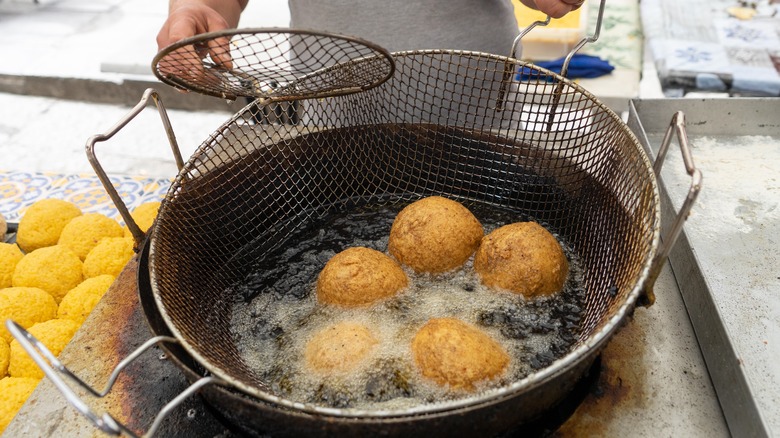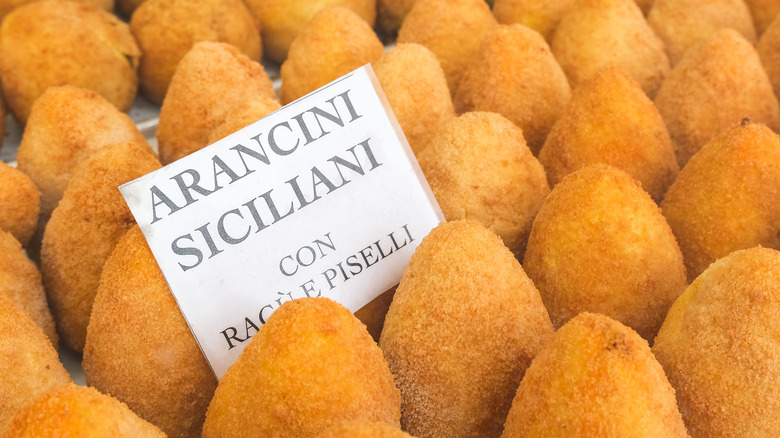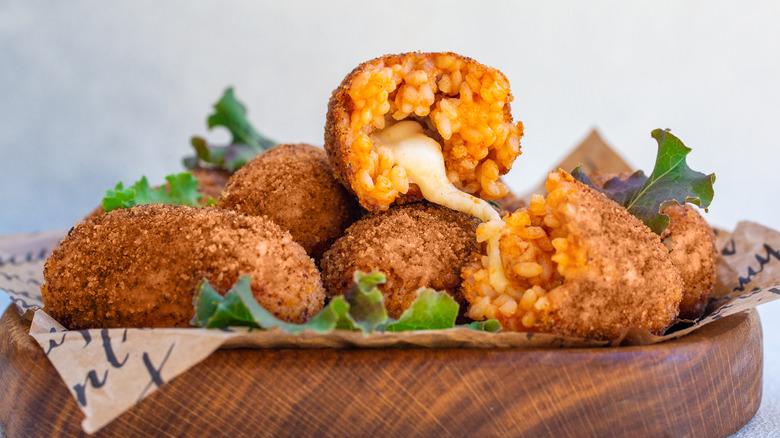Arancini Vs. Supplì: What's The Difference?
There can be little doubt that when Italian cuisine comes up in conversation that pasta is often the star of the discussion. There is a good reason for this, of course. Most everyone loves a good spaghetti carbonara or pesto fusilli. However, rice is just as important to Italian cuisine as pasta, though it is seldom appreciated as such. And though risotto is the most well-traveled, it is hardly the only dish derived from the grain that's been growing in Italy since the 15th century. Estimated to have been first sowed in 1468 in the wetlands outside of Pisa in Tuscany, rice went on to become a staple crop across several Italian regions, per The National Library of Medicine.
According to Italian Made, some of the most famous varieties of Italian rice, including arborio, carnaroli, Roma, balilla, and S. Andrea, were all developed over centuries of cultivation. How rice got to Italy, however, is a matter of debate. Several stories exist, such as rice returning with Crusaders from the Middle East or arriving in Sicily during the Arab conquest. Regardless of when rice arrived on the peninsula, it quickly took hold in the Italian diet. Seemingly unbeknownst to either, both Sicily and Rome created two quite similar, yet different types of fried, breaded rice balls that are enjoyed as simple street snacks. Arancini and supplì de telefono may look practically identical on the outside, but once you bite into them, their differences become immediately apparent.
The arancini of Sicily
Sicilian arancini are an essential part of the island's cuisine, one that Sicilians have no desire to change any time soon. According to Great Italian Chefs, Sicilians are deeply proud and protective of their culinary heritage, favoring the tried-and-true recipes that have sustained them for generations over the come-and-go nature of modern fads. How arancini are made, like all things Sicilian, is not set in stone. Due to countless invasions and occupations throughout history, Sicily's cuisine is awash with influences from across Europe, the Middle East, and Northern Africa.
Said to have originated in the 10th century during Arab rule, arancini are breaded rice balls that have been deep-fried until golden and crisp. As Arabs likely cultivated rice on the island, it is natural that their native cuisine would influence the making of arancini. Traditionally, the rice is boiled and flavored with saffron before being shaped around a core of meat filling, according to Best of Sicily Magazine. Arancini evolved over the coming centuries, with both sweet and savory variations recorded in recipe books. However, with the arrival of tomatoes, an arancini-accompanying ragu sauce became widely popular. Depending upon the location on the island, arancini are shaped either as large eggs or as small, round balls carried about in little newspaper-lined baskets (via Mama Napoli Foods and Great Italian Chefs). Regardless of where in Sicily you find yourself, arancini are sure to be nearby.
Rome's suppli al telefono
Arancini's Roman counterpart is the equally crispy supplì al telefono. From a distance, it is almost impossible to tell these two cousins apart. However, closer examination shows that where arancini are typically round and bulbous, supplì are oblong and pill-shaped. They're also usually smaller than arancini. The classic Roman way of making these is to use precooked short-grain rice, such as arborio or carnaroli, mixed with grated cheese and a plain tomato sauce before being shaped, breaded, and deep fried. The telefono label comes from a version of supplì that adds a ball of mozzarella to the middle of the mixture. When deep-fried and pulled apart, the mozzarella creates a long, gooey line of cheese that stretches like a telephone cable (via Devour Tours).
It's uncertain exactly when supplì began to appear on the streets of Rome, but there is an amusing anecdote that, whether myth or fact, sticks to supplì like its cheesy interior. According to Toni Brancatisano, the name supplì is actually derived from the French word for surprise. When Napoleon and his army occupied Rome during the 19th century, French soldiers were reportedly delightfully surprised when they bit into the inner ball of melty mozzarella. Originally sold out of carts or sidewalk stalls, supplì is today found in pizzerias and bakeries across Rome. Another classic Roman rendition of these crispy bites is the supplì rigaje di pollo, made with the heart, liver, and lungs of a chicken. So, when in Rome ... eat supplì.


